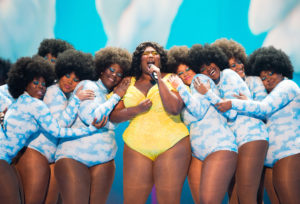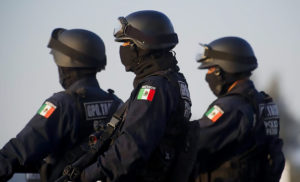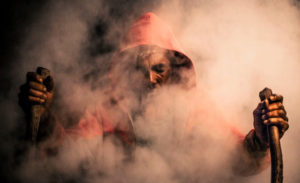It wasn’t the flap of a butterfly’s wing that triggered a transformation in transnational crime, but the steady blows of a metal bollard pulverising the head of a bikie gang member. Anthony Zervas was murdered at Sydney Airport in 2009, after members of the Hell’s Angels and Comanchero gangs discovered that they were on the same flight from Melbourne. The rival bikie groups had each called for reinforcements to meet them at the airport in Sydney, resulting in a brawl in front of horrified travellers that saw Zervas bludgeoned and stabbed to death.
The atrocity brought national attention to a brutal gang war that had, until then, been raging only in the outer reaches of the city. The subsequent need to escape the spotlight focused the minds of gang leaders on their core business model — which is, quite simply, making billions of dollars from the drug trade. Since the infamous airport attack, Australia’s powerful bikie gangs have turned their considerable brawn into brains, evolving into sophisticated transnational criminal organisations that are reshaping global drug networks.
Police say that there are 38 outlaw motorcycle gangs operating in Australia, with around 4,600 patched members and hundreds, or even thousands, of hopefuls waiting in the wings. Culturally, the reach of this relatively small group is great. Bikies have strong connections to Sydney’s nightclub scene, and rugby league and AFL players are frequently chastised for socialising with them. A Home and Away starlet was sprung on a bender with a bikie in 2009 — losing her billionaire media heir boyfriend in the fallout — and last year, a sitting Victorian Senator was forced to step down as deputy leader of her party after it was revealed that she had dated a former Rebels leader while she was on the Joint Law Enforcement Committee.
Bikies have long sat at the top of domestic drug distribution networks, and they’ve no shortage of customers. Australians are notorious fiends for anything in powdered form, buying it at several times the going rate in the United Kingdom or United States. A gram of cocaine retails for around £75 in London, but you’ll pay at least £175 in Sydney. The bikies make an estimated £1.7 billion per year from dealing, a figure that represents a third of the total Australian drug trade — and is rising.
But bikies are increasingly turning their attention to the really lucrative business of importing. This shift became evident in 2021, when Mark Buddle, exiled leader of the biggest and most brutal gang, the Comanchero, sent a message to other leading Sydney criminals stating that he was setting up a Mafia-style “commission”, to control who was importing gear via taxation and price-fixing. The cost of meth had dropped from $250,000 to $80,000 per kilogram in a month, his message lamented, “because there is NO STRUCTURE, no rules, no reasoning and to be honest there’s NO SENSE”.
Strengthening vast global supply chains and creating new ones, the bikies are collaborating with bona fide mafia organisations like the ‘Ndrangheta and Mexico’s Sinaloa cartel. A network of these gangs are working together, having set up outposts in south-east Asia, to be at the forefront of the methamphetamine trade. Indeed, a 2019 United Nations report found that, while established players from China, Hong Kong and Thailand remain central to methamphetamine and heroin manufacturing, outlaw motorcycle gangs from Australia and New Zealand had recently “sought to gain a foothold in the region”. Heightened law enforcement attention in Australia was seen as a driving factor.
The domestic crackdown on the gangs was partly caused by the public outcry following the Airport brawl. Before then, bikie elites were often derided in Australian popular culture as Instagram-obsessed “Nike bikies” — roided-up gym junkies who don’t even ride Harleys. (One leader was known as the “Bathrobe Bikie”, because he had a tendency to pose in Versace loungewear.) But if leaders are more cosmopolitan, their gangs are comprised largely of young men from Sydney’s severely disadvantaged western suburbs, who do the dirty work. The city has seen a spate of high-profile bikie attacks in the last few years, including a bitter drug distribution feud between two bikie-linked clans, the Alameddines and the Hamzys. Scores of shootings which almost wiped out the latter family entirely, and the bloodshed was met with wide condemnation — from talkback radio callers demanding swift action, to then-Prime Minister Kevin Rudd denouncing the brawl as “absolutely unacceptable”. The police promised to step up.
The Alameddines and Hamzys are fairly low-ranking clans, but infighting has plagued the big boys, too. In 2018, a former Comanchero boss, Mahmoud “Mick” Hawi — who was charged with the manslaughter of Anthony Zervas — was murdered by a friend with financial motives. (The accused man was subsequently acquitted and then murdered himself last year.) A report last year from Deakin University challenges the narrative that what drives the gangs is endless patch-on-patch warfare; they are, rather, looking for new ways to do business. “OMCGs have changed in the past 10 to 15 years,” author Professor David Bright said. “Before this, they were very much about the brotherhood and that antisocial bikie lifestyle, but now they’re inviting young members to join simply because they have a criminal history the club finds useful.” The study also found that young men looking to get into bikie gangs aren’t motivated less by being their brothers’ keeper and more by the cash that can be made.
The focus on money-making, as well as the police crackdown, has seen an exodus of senior bikie leaders, who want both to escape the law and oversee offshore operations. Estimates suggest that a third of senior leaders live outside of Australia — in places such as Dubai, Cyprus, Thailand and Turkey — although this trend has been dented in recent months by the extraditions of key figures. Mark Buddle, exiled leader of the Comanchero — and considered the most wanted man in the country — was dragged home late last year with a series of security measures worthy of a war criminal.
Bikies don’t elicit a lot of sympathy, but there’s clear evidence that they’re being over-policed. Data from the two states that provided it shows that the failed prosecution rate for members of OMCGs (outlaw motorcycle gangs) was up to four times higher than the general population. States routinely try to enact anti-association laws, which included bans on operating clubhouses and working in tattoo parlours, and jail time for consorting in public in groups larger than three. These laws are often struck down by the courts.
But it’s the “501 law” that has had the profoundest effect. Brought into effect in 2015, it gives the Immigration Minister the power to deport people born in another country if they’ve spent 12 or more months in jail. Freedom of movement laws between Australia and New Zealand, and the opportunities present in former’s organised crime scene, mean that ambitious young Kiwis travel over the Tasman to ply their trade in Sydney. The 501 law has seen many of them sent back to New Zealand. The irony of Australia effectively creating a modern penal colony isn’t lost on the Kiwis, who have been critical of the practice. New Zealand is decidedly anxious about importing Australian problems to its shores, and with good reason: the Comanchero turned the challenge presented by the 501 law into an opportunity, by opening a New Zealand chapter. It is estimated that Kiwi gang membership in total has doubled to over 8,000 since 2016. Indeed, the nation has had to do some deporting of its own, to the Pacific Islands.
Inevitably, the oceanic drug highway has blossomed as a result. Small island nations, such as Fiji and Tonga — which are in many ways beholden to the two regional leaders — have become fundamental hubs in the trade between the Americas and Australia. Bikie gangs have established chapters in many of them, often thanks to members who have been deported. A report last year by the Lowy Institute found that, in the Pacific Islands, “drug trafficking has evolved significantly with the rise of local actors in transnational criminal networks”. It blamed the deportation policies of Australia, New Zealand and the United States for “exacerbating crime and addiction within Pacific nations”.
Last month, two prominent news stories underlined the extent that the drug trade is now very much a regional issue. A record-breaking 3.2-tonne haul of cocaine, valued at £260 million, was discovered floating in bales in international waters north-east of New Zealand. Greg Williams, director of New Zealand’s National Organised Crime Group, claimed that it had to be bound for Australia — because Aussies would only take 12 months to get through the drugs, while the same amount would take Kiwis 30 years. Then there was the curious case of a group of men found clinging to an ice box off the southern coast of Western Australia. The men claimed that their boat had capsized fishing, but in the following days, both it and 365kg of cocaine had washed up on nearby beaches.
Traffickers are now specialising in these kinds of drug dumps in the poorly-policed international waters in the Pacific, where floating bundles of cocaine are left at particular coordinates to be collected by another waiting vessel. Police don’t patrol these waters to catch these drops, so unless they have inside information, it’s a relatively successful practice. We know that these kind of bold drug importations are now favoured by Australian bikies thanks to an-FBI led international operation where leaders such as Mark Buddle had their conversations monitored by a police-operated encrypted app called ANOM.
Indeed, the role of bikie gangs in the drug trade is set to become a key election issue in New Zealand later this year. The conservative National Party has been emphasising the importance of law and order — pointing out that the new Prime Minister, Chris Hipkins, was police minister during the early and enormous explosion in gang recruitment. Back in Australia, the state of New South Wales, of which Sydney is the capital, goes to the polls in March — and bikies are a big issue. Premier Dominic Perrottet has announced that he’ll be adding a further 30 police to the force’s Raptor Squad, which tackles outlaw motorcycle gangs, a move supported by the Labor opposition. Yet in spite of the law and order frenzy on both sides of the Tasman, there’s an issue that nobody wants to face: there would be no illicit drug trade to control if it wasn’t for the global war on drugs, now into its second century of failure.
Oceania is a fascinating case in the way the global drug trade is changing. Traditional gang hallmarks like loyalty to the badge and firm local control are, like so many other things in this world, giving way to bean counters. Organised crime from all over the world is coming together to maximise profits, and becoming more ruthless in pursuit of them. After all, getting caught means a long jail sentence whether it’s 20kg or two tonnes — so why not go all in?
Disclaimer
Some of the posts we share are controversial and we do not necessarily agree with them in the whole extend. Sometimes we agree with the content or part of it but we do not agree with the narration or language. Nevertheless we find them somehow interesting, valuable and/or informative or we share them, because we strongly believe in freedom of speech, free press and journalism. We strongly encourage you to have a critical approach to all the content, do your own research and analysis to build your own opinion.
We would be glad to have your feedback.
Source: UnHerd Read the original article here: https://unherd.com/




